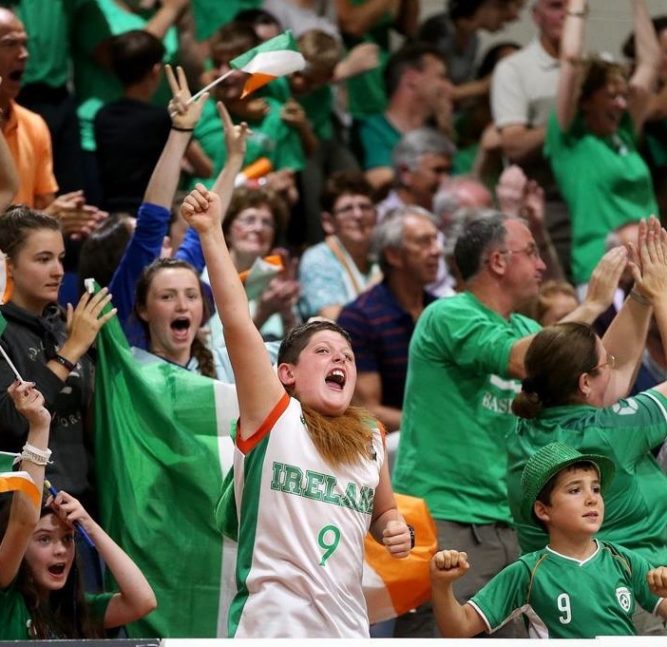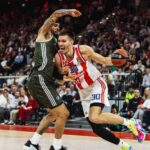
Ireland’s basketball history is littered with what might have, might have, might have…and yeah one more, might have beens. That changed over 10 days in Dublin as one golden generation got it all together to give basketball people in this country something to believe in and a tournament that raised the bar. Emmet Ryan looks back at the FIBA Europe U18 B women’s championships and what kind of a legacy the competition will leave for Irish hoops
Abbotstown is best known for being really far away. The decision to play Ireland’s opener there seemed a bit odd. While the National Basketball Arena is hardly in the centre of Dublin, it’s mentally associated with the sport’s heart here. Abbotstown, that’s just a place where lots of bodies have their HQs. Getting there showed the why. The National Indoor Arena (NIA), opened in January, is quite the building. A huge site, it was home to two of the three courts used for the competition and added the touch of grandeur that more traditional basketball sites like the Oblate simply couldn’t* provide. The FIBA intro music ringing out the NIA’s huge surroundings backed up by a solid crowd really added the touch of pomp to the occasion. It was a good spot to show off Irish basketball.
*And really shouldn’t for that matter. The tight as heck nature of the Oblate is a fundamental part of its charm.
Opening night really couldn’t have gone better for the hosts. With youth tournaments, it’s easy to get focused solely on the primary target of attention. For BiE, it was unquestionably Ireland, but all throughout that first day’s play, the updates from around were spreading fast. Were the Slovak players that good or was Moldova that bad (it would turn out to be emphatically the latter), the Germans are putting an early pasting on Iceland, Great Britain made a big comeback against Ukraine. The job on opening night for Ireland was just getting the win and, even then, the players were amazed by the support that came out for them.
For our analysis series The Ballin After, post-game interviews, and more, subscribe to BallinEurope’s YouTube channel
Yeah, it would turn out that was essentially nothing compared to what was ahead. A dominant performance over Slovak Republic and a rout of Moldova followed over the next two days before the big test for the tournament organisers. There is no greater draw for a team wearing green than getting Great Britain in the door. If they could get the bodies out for this one, it would be big. The arena sold out in rapid time. Tallaght was a cauldron and the British side was rarely in it, with the rowdy Irish crowd getting behind their crew from the off. 4 and 0. This was starting to look like more than something to enjoy. The games were getting real and it was clear the fans got this.
With followers tuning in from Kenya, Russia, Thailand, the United States, and so many other haunts the global Gaels call home, this team was riding a wave of support. Within that old barn in Tallaght however something else good was happening. Folk were arriving well in advance of opening tip and weren’t leaving en masse once Ireland finished. The teams with the late afternoon slot were getting to play in front of a largely full arena and the crowd was still there for the bulk of the late evening slot. The experience was going beyond the Irish team and giving the sides that made the trip to Dublin an unexpected experience.

REPRO FREE***PRESS RELEASE NO REPRODUCTION FEE***
FIBA Under 18 Women’s European Championship, National Basketball Arena, Tallaght, Dublin 8/8/2017
Great Britain vs Ireland
Ireland’s Claire Melia with Maya Price of Great Britain
Mandatory Credit ©INPHO/Tommy Dickson
Thursday was the rest day before the wildest part of any youth competition. The final three days are brutal for all involved. Quarters, semis, and medal games all in quick succession, the games that mattered for promotion to the highest level in the sport, all while keeping order on the classification games.
The focus for the masses, and oh how they came, was Israel. A nation with a deep basketball history that had showed its mettle in the group stages. Ireland just doesn’t normally enter a game with this kind of an opponent expecting to win. Irish teams rarely would go into such games with punters thinking they can win. That’s different. The players might always think they have a shot but Irish fans are used to having more hope for the right break than any real expectation.
BallinEurope now has merch, like actual merch, t-shirts, phone covers, and even pillows. Check it all out on our RedBubble page.
The road here hasn’t been easy. The 1980s are still stuck in a lot of people’s heads, when some top tier American talent including double NBA champion Mario Elie plied the hardwood here. The men’s side had some good runs through the 1990s and into the 2000s, winning the Promotions Cup (now FIBA Small Countries) and narrowly missing out to Denmark on promotion from FIBA’s old B division in the EuroBasket 2005 cycle. Then came the bust, or as our non-Irish readers would better know it as the global economic crash of 2008. Basketball was hit hard. The coffers weren’t so much empty as that the coffers themselves had to be sold off and even then that didn’t come close to covering the mountain of debt.
The national programs were shuttered indefinitely before the decade was out. Youth prospects coming through had more reasons than ever to look elsewhere. The pipeline to making something out of basketball here was wrecked.
But the people remained. The people got organised and piece by piece started to rebuild. First one underage side each for boys and girls. Then two, then the full allotment through to under 20. Development squads. All the while with no central money available to invest. Everything Irish hoops had was required to service the debt. Instead the parents of ballers, their friends, their clubmates, saw the need to fight. They raised money any way they could, including bucket collections outside of Croke Park, the home of Gaelic games here. The crash was not going to kill the game here. Not on their watch.
Still, without a full programme, it was anything but easy. Even with talented players, the lack of experience against international opposition showed. Losses came but every win made these volunteers more resolute. They became more certain they would succeed and then along came this generation.
Claire Melia, who has been getting a crazy amount of college offers by all accounts, has been the face but we’ve had Irish teams with one superstar before that were found out for lack of depth. What made this group different was the depth. Melia might be the cream of the crop but this was a far deeper roster than anyone could recall seeing at youth level. Top six finishes at European tournaments followed and suddenly it was a case of wondering if they could get it all together for one huge push.
In 2014, Basketball Ireland decided to go for a 2017 youth tournament. Most of this squad still hadn’t tipped a ball in under 16 play yet but the stage was set. A run to the quarter finals by the senior women in the 3×3 at the European games followed in 2015, then both senior men and women returned to international play a year later. The pieces were coming together and the green jersey was back out there (personal aside, the green on navy Ireland used at those 3×3 games in Baku were really awesome looking).
Once Ireland got awarded this competition, the focus from the community was immediately on how this could be the event to give the sport here a real launchpad. A team that could get promotion to the top flight coupled with a chance to deliver an effective event was a big prize.
Now it was all going to come down to 40 minutes against a country mad about the sport. The Israel side took the court to a crowd of Irish people with just as much passion. It was tense, even on press row, but the Irish hung with them and eventually found some breathing room. A late three by Maeve Phelan, on a day where it felt like Ireland couldn’t do anything beyond the arc, made the difference. At full-time, coach Tommy O’Mahony knew what his side was on the verge of.
So here we were, less than 24 hours later and for the second straight night Ireland was facing the biggest game in the history of the sport here. A shot at an A division in Europe for the first time ever. This was about as far from normal as it gets. The game looked a coin toss based on what had come before. It started like a nightmare. Poland had the bigs and were brutalising Ireland up the gut. A 7-0 run that turned into a 12-4 lead and Ireland were in trouble. Everything looked slick from the Poles. Then Ireland forced the pace of the game to change, it turned more into an alley fight, and the fight came from the home side.
At the half-time break, Poland looked rattled. Ireland were only up 28-23 but looked capable of putting this one to bed. The home side started the third well but a stern fightback by Poland towards the end of the quarter left just a bucket between the sides going into the last 10 minutes.
Everything was about ‘biggest’ or ‘most important’ in history at this stage. 10 minutes to get to a place no Irish side had sniffed in forever. 10 minutes to give this crowd yet another night to forget. The job was done. Tears were sobbed, the crowd lost its collective mind. The players could breathe.
Germany. Well, they were just plain better than Ireland on Sunday. The crowd didn’t mind all that much. The tension that had been there the previous pair of nights had gone. This was going to be a celebration of victory no matter what the scoreboard said that night. Ireland wasn’t back, you can’t be back to a place you’ve never been before. Ireland had proved it belonged.
All those years of struggles, the dark times where hope seemed pointless, had been paid off over 10 great days. The ovation given by the crowd, including plenty of Olé Olé chants, was for conquering heroes. A national side that played like a club side had gone out and got the biggest of jobs done like it was just another assignment. Those who have toiled for the game here over the years, like Gráinne Dwyer and Meaghan Hoffman, embraced the players as they got their medals. This was a time for celebration.
Away from the public eye afterwards it was FIBA’s turn to talk. Kamil Novak, FIBA Europe’s executive director, addressed the organisers afterwards. He told them that they had achieved something fantastic and to look forward to the next one. That’s in Cork next year when some of the crew that played in Dublin during this campaign will be in contention for senior roster spots at the FIBA Small Countries. Ireland’s never won gold in the women’s version, talking silver four times. The road to Cork and the story behind that can wait for another beer, not that this corner is ever short of a pint.
After the Great Britain game I toasted each victory by this crew in my local, the Blackbird, not because of the pride I felt in them for their wins but for the inspiration they gave to those coming behind them. A new generation of young Irish ballers will see what Melia, Phelan, Dayna Finn, Bronagh Power Cassidy, Louise Scannell, and so many others did here and look to top it. That’s a legacy. Not bad for a bunch of teenagers.
To keep up to date with everything on BiE, like BallinEurope on Facebook





Leave a Reply